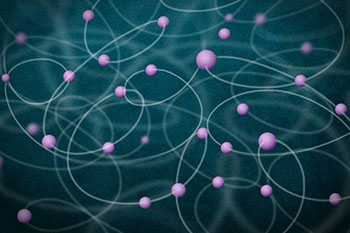
Artist’s rendering of an entangled suite of atoms. [Image: Christine Daniloff/MIT and Jose-Luis Olivares/MIT]
In a remarkable demonstration of “quantum weirdness,” a team of scientists from the U.S. and Serbia have used a weak laser pulse to entangle an ensemble of nearly 3,000 atoms, with the entanglement heralded by a single photon (Nature, doi: 10.1038/nature14293). The ability to mutually entangle such a large number of atoms—some 17 times more than the largest mutual entanglement shown to date—could, according to the researchers, enable substantially improved accuracy in atomic clocks, as well as opening up new opportunities in quantum communication.
Entanglement, an inherent property of quantum systems, happens when the quantum states of multiple particles are correlated such that a change in one implies a change in the other, even if the particles are widely separated—Einstein’s famous “spooky action at a distance.” Most demonstrations of entanglement within large groups of atoms have generated entanglement within pairs of atoms in the group. Scientists have long sought ways to take the next step, and create large ensembles of atoms that are mutually entangled with one another.
To move toward that goal, a research team led by Vladan Vuletić of the Massachusetts Institute of Technology, USA, started by suspending a cloud of nearly 3,000 87Rb atoms, which had been laser cooled to a frigid 50 microkelvins, into an optical cavity framed by weakly transmitting, highly reflecting mirrors on either side. They then sent a weak, vertically polarized laser pulse into the cavity, which bounced some 5,000 times between the mirrors, passing through the atom cloud within the cavity and interacting with the atoms before leaking out at the other end, where the photons were detected and their polarization read.
In most cases, the polarization of the laser pulse did not change in its trip through the cavity. But occasionally, the team found a single photon where the polarization had been rotated, owing to its interaction with the “quantum noise” of the collective spin state of the atoms in the cavity. Under quantum theory, when a photon was detected for which the polarization had been rotated 90 degrees, the photon’s detection could be interpreted as heralding the collapse of the atomic ensemble into an entangled state.
The scientists verified that interpretation by measuring the so-called Wigner function of the atomic ensemble. They found that the function, a specific quantum probability distribution in phase space, was negatively valued for the ensemble associated with a horizontally polarized heralding photon—“one of the strictest criteria” for entanglement, according to the paper. And, using another measure called entanglement depth, they deduced that nearly all of the atoms in the ensemble (~2,910, or some 90 percent of the atoms in the ensemble) must be mutually entangled, a showing that far outstrips the previous record of 170 out of 2,300 atoms in a spin-squeezed state.
The team says that this new technique for generating and using non-classical entangled states could push atomic clock accuracy to new levels. That’s because the accuracy of a clock based on an entangled ensemble should be proportional to the number of particles, while the accuracy of a clock based on unentangled particles scales with the square root of the number of particles. And the researchers are working on techniques using detection of two or more rotated photons to create even larger, more robust entangled ensembles that could find use not only in more accurate clocks but in other quantum sensor technology.
